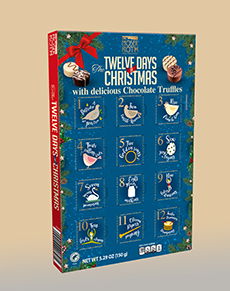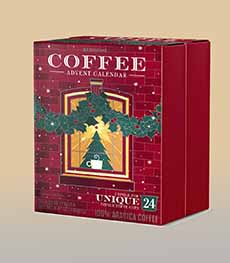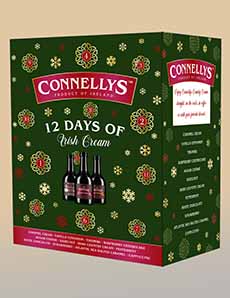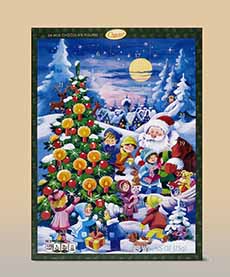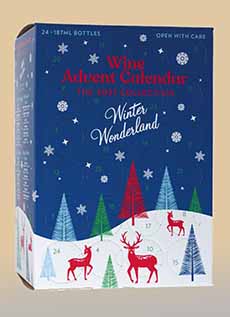Advent Calendars: Delightful Holiday Gifts That You Need To Buy Now
|
We love Advent calendars, both giving them and receiving them. But they’re not a last-minute gift: You need to give them to the recipients before December 1st. That’s why for the past few years, we’ve turned to giving them to our loved ones at Thanksgiving dinner. We would spend hours poring over websites to find the right calendar for each person. This year, Aldi has made it oh-so-easy for us, as you’ll see below. The 2021 wine and beer Advent calendars (which are the priciest) have already been released*. Others start rolling out tomorrow, November 3rd, which is National Advent Calendar Day. “Rolling out” means that not all calendars will be available on November 3rd, so you may have to come back. However, anyone who shops at one of the 2,100-plus Aldi stores in the U.S. is probably a “regular.” The Advent calendar dates to the beginning of the 19th century, when German Lutherans made chalk marks on doors or lit candles to count down the days leading up to Christmas: the fourth Sunday before Christmas through Christmas Eve. Early versions were homemade and simple: Families would mark chalk lines on doors, light candles, or hang religious pictures, one for each day. The first-known commercial Advent calendar is from 1851, appearing in a children’s book by Elise Averdieck. One origin story credits Gerhard Lang (1881-1974) as the inventor of the printed Advent calendars, beginning in 1904. Lang’s calendar was inspired by one that his mother had made for him: 24 cookies (some say candies) sewn onto the lid of a box. He was allowed to eat one of them every day during the Advent period. Other parents created their own handmade versions. Remembering mom’s cookie countdown, Lang created a pilot calendar in 1904. He printed calendars with small colored pictures that children could attach to a cardboard backing—one picture per day. The first printed, commercially distributed Advent calendar debuted in 1908 [source]. The calendars became commercially viable and were made with both religious and non-religious themes. The now-familiar format with little doors that opened out for the reveal appeared in the 1920s. Religious calendars typically counted down each day with a prayer or spiritual imagery—nativity scenes, angels, and biblical verses behind each door. Secular versions for children had pieces of candy or tiny toys. These first Advent calendars were called “Nicholas calendars,” since they were given out on December 6th, St. Nicholas’ Day. Then, calendars were made to begin on December 1st and were called “Christmas calendars.” These typically didn’t follow the full four-week period of Advent, because the date varies in any particular year, which can range from November 27th to December 3rd. Instead, they marked the 24 days leading up to Christmas. The name “Advent calendar” was established when some calendars were published with the annually variable number of Advent days [source]. Advent, from the Latin word adventus, means “coming.” It’s a time of waiting and preparation for the celebration of the Nativity of Jesus, on Christmas Day. The fun of modern Advent calendars is opening one of the 24 closed windows/doors, that mark each day until Christmas. Young or old, opening the daily window has anticipation and surprise. After World War II, the tradition spread beyond Germany. In the 1950s, a man named Richard Sellmer began mass-producing Advent calendars and exporting them internationally, which helped popularize them worldwide. The 1950s also saw the introduction of chocolate-filled calendars, which became hugely popular. President Dwight Eisenhower is credited with giving Advent calendars a huge popularity boost in the U.S. when national newspapers published a photograph of him opening one with his grandchildren in 1953. For most of its history, the Advent calendar was targeted to children. The surprises behind the window were a piece of candy, a charm, a mini toy, or a holiday-themed image (Santa, Rudolph). There are still inspirational versions. The calendars can be basic or very elaborate. In recent years there’s been a trend to adult-appropriate Advent calendars, that focus on bottles of beer or wine, fine chocolates, coffee and tea, and even beef jerky. OMG: The Advent calendar choices are so great at Aldi, we need to go nowhere else. But caveat emptor: Some sell out quickly. Some calendars have windows for the full 24 days, while others are for 12 days. The Sparkling Wine Countdown To The New Year has seven 187ml bottles of wine. Take your pick of 26 calendars: |
|
|
|
________________ *For wine and beer calendars, note that not all states or municipalities allow alcohol sales at grocery stores. CHECK OUT WHAT’S HAPPENING ON OUR HOME PAGE, THENIBBLE.COM. |
||
